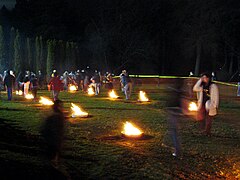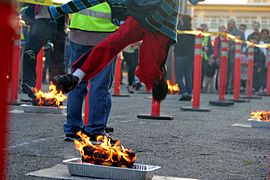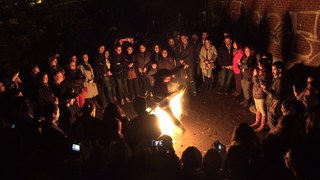| Revision as of 17:20, 20 March 2016 editHistoryofIran (talk | contribs)Autopatrolled, Extended confirmed users, Pending changes reviewers97,726 edits The discussion is still ongoing, nothing has been decided yet, therefore it should remain like it was before.← Previous edit | Revision as of 15:26, 22 March 2016 edit undoPahlevun (talk | contribs)Autopatrolled, Extended confirmed users33,054 editsNo edit summaryNext edit → | ||
| Line 21: | Line 21: | ||
| }} | }} | ||
| '''Chaharshanbe Suri'''<ref name="Iranica"/> ({{lang-fa|چارشنبهسوری}}, usually pronounced |
'''Chaharshanbe Suri'''<ref name="Iranica"/> ({{lang-fa|چارشنبهسوری}} ''Čahār-šanba(-e)-sūrī'',<ref>{{cite encyclopedia |editor-last=Moeen|editor-first=Mohammad|editor-link= Mohammad Moeen |encyclopedia=]|title=چارشنبهسوری|trans-title=Č.-šanba(-e)-sūrī|language=Persian|edition=One-volume edition based on 6-volumes|year=2002|orig-year=1972|publisher=Moeen Publications||location=Tehran|isbn=9789647603072}}</ref><ref>{{cite encyclopedia |editor-last=Mosaheb|editor-first=Gholamhossein |editor-link= Gholamhossein Mosaheb|encyclopedia=]|title=چارشنبهسوری|trans-title=Čahār.Šanbe suri|language=Persian|edition=2nd|year=2002|orig-year=1966|publisher=]|location=Tehran|isbn=964303044X|page=811|volume=1}}</ref> usually pronounced ''Čāršanba-sūrī'';<ref name="Iranica">{{cite encyclopedia|title =ČAHĀRŠANBA-SŪRĪ |encyclopedia=Encyclopædia Iranica|date=December 15, 1990|orig-year=December 15, 1990|publisher=Bibliotheca Persica Press|location=New York City|url =http://www.iranicaonline.org/articles/caharsanba-suri|volume= IV|last1=Kasheff |first1=Manouchehr |last2=Saʿīdī Sīrjānī|first2=ʿAlī-Akbar|editor-last=Yarshater|editor-first=Ehsan|access-date=March 15, 2016|series=6|pages=630-634}}</ref> {{lang-az|Çərşənbə Bayramı}}; {{lang-ku|''Çarşema Sor''}}), also called the '''Festival of Fire''',{{fact|date=March 2016}} is an ] festival celebrated on the eve of the last ] before ] (the Iranian New Year).<ref>{{cite encyclopedia |last=Persian Fire-Jumping Festival |first=Alison Fu | title= ČAHĀRŠANBA-SŪRĪ | encyclopedia= | accessdate=2012-03-18|url=http://www.dailycal.org/2013/03/13/persian-fire-jumping-festival-delights-berkeley-residents/}}</ref> | ||
| ==Name== | ==Name== | ||
| ===Etymology=== | ===Etymology=== | ||
Revision as of 15:26, 22 March 2016
This article is about the festival. For the film, see Chaharshanbe Suri (film).| Chaharshanbe Suri | |
|---|---|
 Charshanbe Suri in New York City, March 2016 Charshanbe Suri in New York City, March 2016 | |
| Observed by | |
| Type | National, ethnic, cultural, historical, international |
| Celebrations | Jumping over fire, fireworks |
| Date | The last Wednesday eve before the vernal equinox |
| Frequency | Annual |
| Related to | Nowruz, Sizdah Be-dar |
Chaharshanbe Suri (Template:Lang-fa Čahār-šanba(-e)-sūrī, usually pronounced Čāršanba-sūrī; Template:Lang-az; Template:Lang-ku), also called the Festival of Fire, is an Iranian festival celebrated on the eve of the last Wednesday before Nowruz (the Iranian New Year).
Name
Etymology
The name of the festival consists of the words Charshanbe (or Chaharshanbe), the Persian for Wednesday, and sur, which is a variant of sorkh ( Error: {{Lang}}: text has italic markup (help); "red") referring either to the fire itself or to the ruddiness. It is commonly translated as Wednesday Light or the Red Wednesday. Red color symbolizes good health and ripeness in the tradition.
Other local names
Variant local names of the festival include:
- Template:Lang-ku, "Red Wednesday" (Sanandaj, Iranian Kurdistan)
- Template:Lang-fa, "Red Wednesday" (Esfahan)
- Template:Lang-az, "Festival of Wednesday" (Iranian Azerbaijan)
- Template:Lang-az, "Goodbye Wednesday" (Iranian Azerbaijan)
- Template:Lang-az, "Last Wednesday" (Azerbaijan Republic)
- Template:Lang-az, "Fire Wednesday" (Azerbaijan Republic)
Observances
Charshanbe Suri is a prelude to Nowruz (the Iranian New Year), and is obtained by fireworks and jumping over fire. Mixed nuts and berries are also served during the celebration.
Jumping over fire
The celebration usually starts in the evening, with people making bonfires and jumping over them.
The traditional poetic quote zardi ye man az to, sorkhi ye to az man is also sung, which literally means "my yellow is yours, your red is mine." This means you want the fire to take your pallor, sickness, and problems and replace them with warmth and energy. It is a purification rite, which is traditionally regarded necessary before the arrival of spring at the vernal equinox.
-
Mohammad Reza Pahlavi, the last monarch of Iran, jumping over fire
-
 Charshanbe Suri in Vancouver,
Charshanbe Suri in Vancouver,
March 2008 -
 Charshanbe Suri in Berkeley, California,
Charshanbe Suri in Berkeley, California,
March 2013 -
 Charshanbe Suri in New York City,
Charshanbe Suri in New York City,
March 2016
Banging spoons
The festival has also a custom similar to Trick-or-treating, in which people wear disguises and go door-to-door to bang spoons against plates or bowls and receive packaged snacks. The custom is called Qashoq zani ( Error: {{Lang}}: text has italic markup (help)), translated as "Banging spoons."
Historical background
Ancient origin
The origin of the festival dates back to at least 1700 BC, during the early Zoroastrian era. Ancient Iranians celebrated the festival of Hamaspathmaedaya (Avestan: Hamaspaθmaēdaya), the last five days of the year in honor of the spirits of the dead, which is today referred to as Farvardigan. They believed that the spirits of the dead would come for reunion. There were seven holy immortalities (Amesha Spenta) that were honored, and were bidden a formal ritual farewell at the dawn of the New Year. The festival also coincided with festivals celebrating the creation of fire and humans. In the Sassanid era, the festival was divided into two distinct pentads, known as the lesser and the greater Panje. The belief had gradually developed that the Lesser Panje belonged to the souls of children and those who died without sin, whereas the Greater Panje was for all souls.
Qajar period
A custom once in vogue in Tehran was to seek the intercession of the so-called Pearl Cannon (Tup-e-Morvarid) on Charshanbe Suri. This heavy gun, which was cast by the Persian foundryman Ismāil Isfahāni in 1800, during the reign of Fath Ali Shah of the Qajar dynasty, became the focus of many popular myths. Until the 1920s, it stood in Arg Square ( Error: {{Lang}}: text has italic markup (help)), to which the people of Tehran used to flock on the eve of Charshanbe Suri; spinsters and childless or unhappy wives climbed up and sat on the barrel or crawled under it, and mothers even made ill-behaved and troublesome children pass under it in the belief that doing so would cure their naughtiness. These customs died out when the Pearl Cannon was moved to the Army's Officers' Club, sometime in the 1920s. There was also another Pearl Cannon in Tabriz. Girls and women used to fasten their dakhils (pieces of a paper or cloth inscribed with wishes and prayers) to its barrel on the eve of Charshanbe Suri. In times, the cannon had been used as a sanctuary for political or non-political fugitives to be immune to arrest or to protest from family problems.
Sadegh Hedayat, Iranian writer of prose fiction and short stories, has a book with the name of this cannon, Tup-e-Morvarid, that criticize the old beliefs of Iranian folklore. The book points also to the origin of the Pearl Cannon.
Today, the Pearl Cannon is placed in the opening of the Building Number 7 of the Ministry of Foreign Affairs in the 30th Tir Avenue, and the Cultural Heritage Organization of Iran is still in argument with the ministry to displace the gun to a museum.
Astrology
| This section does not cite any sources. Please help improve this section by adding citations to reliable sources. Unsourced material may be challenged and removed. (March 2016) (Learn how and when to remove this message) |
Much of the symbolism of the act of jumping over fire is linked to astrological connotations associated with the sign of Pisces (Esfand), related to the subconscious mind, hidden resources, hidden problems, and social responsibility. The human has to face his ultimate fears, and he does so by jumping over fire. Wednesday is chosen because of its ancient association with the fourth day of Mercury, and Mercury being the messenger of Gods.
Notes
- 1. Char-shanbe, meaning "the fourth Shanbe," is the fourth day of the week in Iran, based on the Sunday-first convention.
References
- ^ Kasheff, Manouchehr; Saʿīdī Sīrjānī, ʿAlī-Akbar (December 15, 1990) . "ČAHĀRŠANBA-SŪRĪ". In Yarshater, Ehsan (ed.). Encyclopædia Iranica. 6. Vol. IV. New York City: Bibliotheca Persica Press. pp. 630–634. Retrieved March 15, 2016.
- Moeen, Mohammad, ed. (2002) . "چارشنبهسوری" [Č.-šanba(-e)-sūrī]. Moeen Encyclopedic Dictionary (in Persian) (One-volume edition based on 6-volumes ed.). Tehran: Moeen Publications. ISBN 9789647603072.
{{cite encyclopedia}}: Cite has empty unknown parameter:|1=(help) - Mosaheb, Gholamhossein, ed. (2002) . "چارشنبهسوری" [Čahār.Šanbe suri]. The Persian Encyclopedia (in Persian). Vol. 1 (2nd ed.). Tehran: Amirkabir. p. 811. ISBN 964303044X.
- Persian Fire-Jumping Festival, Alison Fu. ČAHĀRŠANBA-SŪRĪ. Retrieved 2012-03-18.
- ""چرشنبه بایرامی" سنتی کهن در آذربایجان/ سنتی که اسیر بدعت های نامبارک شد". Khabaronline. 14 March 2016. Retrieved 14 March 2016.
- Massoume Price, Chahar Shanbeh Soori, The Fire Festival of Iranian Peoples
- Massoume Price, Chahar Shanbeh Soori, The Fire Festival of Kurdish Peoples
- Encyclopaedia Islamica. Toop e moorvarid. (in Persian)
- © CHN (Cultural Heritage News Agency) of Iran (in Persian)
- © CHN (Cultural Heritage News Agency) of iran (in Persian)
External links
- Persian Fire-Jumping Festival in the Netherlands on YouTube (Video)
- Persian fire-jumping festival delights Berkeley residents (Photo)
See also
| Nowruz | |
|---|---|
| Traditions | |
| Part of | |
| Related | |
| Variations | |
| National symbols of Iran | |
|---|---|
| Flag | The Three-Color Flag |
| Emblems |
|
| Anthems |
|